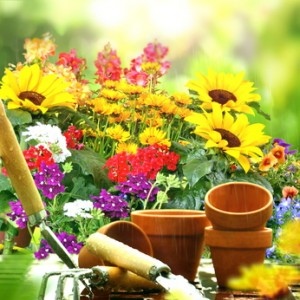 When the average homebuyer goes house hunting, he or she tends to be very focused on the house itself while the surrounding property is secondary. But, even if you’re not an avid gardener, a well-designed home garden can become an extension of your living space. Especially in milder climates, decks, patios, and vegetable and flower beds can all enhance both lifestyle and living space. Not to mention open play areas or the beauty and shade provided by trees.
When the average homebuyer goes house hunting, he or she tends to be very focused on the house itself while the surrounding property is secondary. But, even if you’re not an avid gardener, a well-designed home garden can become an extension of your living space. Especially in milder climates, decks, patios, and vegetable and flower beds can all enhance both lifestyle and living space. Not to mention open play areas or the beauty and shade provided by trees.
You can design your garden based on whatever elements are most important to you, whether it’s enhancing privacy, growing your own food, or simply creating a peaceful environment. If you recently purchased a home, you may be wondering how to start a home garden. Like a home remodel, there are many different ways to go about designing a home garden.
Planning a Home Garden
To start planning a home garden, sketch out the available area on paper. Start by identifying natural borders, obstacles to plan around (such as trees) and places to plant leading features of your garden. It is important to note points from which people will enter and exit the garden area by including gates, arbors and paths in the sketch. Identifying which areas are most appropriate for certain plants is also important. Areas that get direct sunlight for most of the day are great for growing vegetables, but many plants prefer partial shade. Noticing the year-round conditions of your yard will help you select the right plants, potentially saving time and money as you start a home garden.
A spacious lawn forms the foundation of many landscape gardens. The lawn and mass plantings can construct the framework of the garden. If you take this approach, keep some open space in the center, and plant around the borders of your lawn to act as a frame. The gardener then must determine the central feature in the space. For many home gardeners, this is the house. Landscaping elements should work to make the home the focal point of the garden design.
Trees and Shrubs in a Home Garden
These major garden features not only help to emphasize the home, but they also provide shade and protection for the home. They can also provide energy savings. Including trees and shrubs in a home garden can help lower a home’s heating and cooling costs by as much as 50 percent in the summer and 8 percent in the winter, according to the American Society of Landscape Architects.
Trees and bushes look best when they are allowed to grow freely in a natural way. This helps to achieve a continuous flow of form and color. However, research should be done about the size of full-grown tree and bush types. Plant them far enough away from the house to prevent them from growing into the house or possibly causing damage to the roof and gutters.
Flower Power
Flowers serve as ornaments, supplying variety, color and emphasis. They appear most vibrant when planted against a background of foliage. While a full flower garden should be planted toward the rear or one side, flowers can be placed along borders or other masses of foliage.
Border planting of flowers helps establish boundaries. Perennials and wildflowers work well in flower borders. Easy-to-grow annuals such as marigolds and petunias can fill in empty spaces.
Plants hold value not only for their flowers but also their foliage. Common flowers such as zinnia and gaillardias boast attractive foliage, making home gardens interesting long before the flowers blossom.
A plant’s importance is not so much tied to the plant itself as to the position it occupies and the way it enhances the structural design of the garden. One flower planted along a border can have a far greater impact than 20 flowers in the middle of a lawn.
Other Garden Features
Adding plants isn’t the only way to landscape. There are many features that can enhance a home garden, including a stone or wood patio, some lawn furniture, lighting or garden art. Paths can be incorporated with pavers, wood chips or gravel, and can be either meandering or destination-oriented. Interesting water features can be included, such as birdbaths or fountains, or for larger spaces, ponds for Koi or ducks.
A home’s landscape also includes the other buildings on the property, such as sheds, garages and fences. A fresh coat of paint on these might be a landscape improvement.
Another way to add interesting garden features is by encouraging wildlife in the garden. Feeders are a good way to lure birds, squirrels and other animals, but many native plants also provide the food and shelter that animals need to survive. The American Horticultural Society recommends adding places in your garden for nesting both on and off the ground, such as layers of thick and thorny evergreens. They also warn against using synthetic chemical pesticides, as these can harm wildlife.
